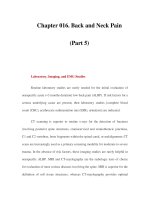Chapter 084. Head and Neck Cancer (Part 6) ppt
Bạn đang xem bản rút gọn của tài liệu. Xem và tải ngay bản đầy đủ của tài liệu tại đây (34.03 KB, 5 trang )
Chapter 084. Head and Neck Cancer
(Part 6)
Chemoprevention
β-Carotene and cis-retinoic acid can lead to the regression of leukoplakia.
However, cis-retinoic acid does not reduce the incidence of second primaries
Treatment Complications
Complications from treatment of head and neck cancer are usually
correlated to the extent of surgery and exposure of normal tissue structures to
radiation. Currently, the extent of surgery has been limited or completely replaced
by chemotherapy and radiation therapy as the primary approach. Acute
complications of radiation include mucositis and dysphagia. Long-term
complications include xerostomia, loss of taste, decreased tongue mobility, second
malignancies, dysphagia, and neck fibrosis. The complications of chemotherapy
vary with the regimen used but usually include myelosuppression, mucositis,
nausea and vomiting, and nephrotoxicity (with cisplatin).
The mucosal side effects of therapy can lead to malnutrition and
dehydration. Many centers address issues of dentition before starting treatment,
and some place feeding tubes to assure control of hydration and nutrition intake.
About 50% of patients develop hypothyroidism from the treatment; thus, thyroid
function should be monitored.
Salivary Gland Tumors
Most benign salivary gland tumors are treated with surgical excision, and
patients with invasive salivary gland tumors are treated with surgery and radiation
therapy. Neutron radiation may be particularly effective. These tumors may recur
regionally; adenoidcystic carcinoma has a tendency to recur along the nerve
tracks. Distant metastases may occur as late as 10–20 years after the initial
diagnosis. For metastatic disease, therapy is given with palliative intent, usually
chemotherapy with doxorubicin and/or cisplatin.
Further Readings
Adelstein DJ et al: An intergroup phase III comparison of standard
radiation therapy and two schedules of concurrent chemoradiotherapy in patients
with unresectable squamous cell head and neck cancer. J Clin Oncol 21:92, 2003
[PMID: 12506176]
Bernier J et al: Postoperative irradiation with or without concomitant
chemotherapy for locally advanced head and neck cancer. N Engl J Med
350:1945, 2004 [PMID: 15128894]
Bonner JA et al: Radiotherapy plus cetuximab for squamous-
cell carcinoma
of the head and neck. N Engl J Med 354:567, 2006 [PMID: 16467544]
Brockstein B, Vokes EE: Concurrent chemoradiotherapy for head and neck
cancer. Semin Oncol 31:786, 2004 [PMID: 15599856]
Cohen EE et al: The expanding role of systemic therapy in head and neck
cancer. J Clin Oncol 22:1743, 2004 [PMID: 15117998]
Forastiere AA et al: Concurrent chemotherapy and radiotherapy for organ
preservation in advanced laryngeal cancer. N Engl J Med 349:2091, 2003 [PMID:
14645636]
Pfister DG et al: American Society of Clinical Oncology clinical practice
guideline for the use of larynx-
preservation strategies in the treatment of laryngeal
cancer. J Clin Oncol 24:3693, 2006 [PMID: 16832122]
Seiwert TY et al: The chemoradiation para
digm in head and neck cancer.
Nat Clin Pract Oncol 4:145, 2007
Slebos RJ et al: Gene expression differences associated with human
papillomavirus status in head and neck squamous cell carcinoma. Clin Cancer Res
12:701, 2006 [PMID: 16467079]
Vokes E et
al: Weekly carboplatin and paclitaxel followed by concomitant
TFHX chemoradiotherapy: Curative and organ preserving therapy for advanced
head and neck cancer. J Clin Oncol 21:320, 2003 [PMID: 12525525]









